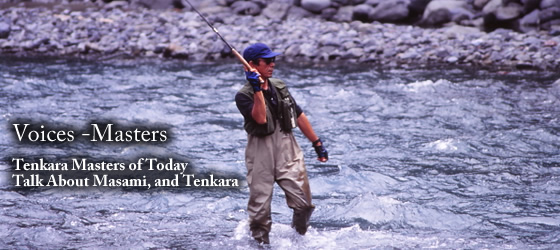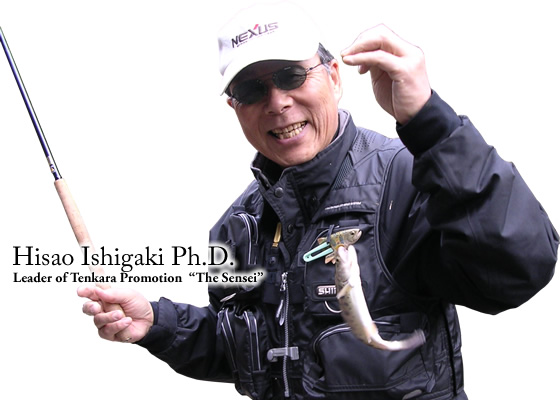証言1

Hisao Ishigaki Ph.D.

Born 1947. Professor at Aichi Institute of Technology
A prominent figure in vision research. Participated in development of the
Nintendo DS Game “Vision Training in Minutes a Day”.
An avid Tenkara fan and promoter of Tenkara with many appearances
in Television and videos.
He has published numerous books on Tenkara. Known in Japan as
“Professor Tenkara”, “King of Tenkara”. Has over 37 years of experience
as a Tenkara angler.
Prof. Ishigaki’s Tenkara Tackle
Rod: SHIMANO “Honryu Tenkara ZE”
Casting Line: SANSUI fluorocarbon level line #4 5.0~7.0m plus tippet
Uses mainly one pattern of kebari in black only
~Tenkara~ The Traditional Japanese Fly Fishing
Hisao Ishigaki
Tenkara is a traditional Japanese method of fly fishing used to catch our native trout such as Amago, Yamame, and Iwana. They were a valuable protein source for small communities deep in the mountains of Japan in the days passed. We do not know exactly how old Tenkara is. At this point in time, a 130 year old document mentions Tenkara, which is the oldest written proof we have found. In my opinion there’s no doubt it dates back further. I estimate that a form of fly fishing existed in Japan over 1000 years ago. We no longer have those professional fishermen, and today Tenkara anglers enjoy it as a sport or a hobby.
Equipment used in Tenkara is very simple, very different from western fly fishing. Only a rod, line, and a kebari are used. This method was developed over many decades perhaps centuries to suit the environment of Japan and fishermen who made a living off their catch. Modern day Tenkara has been modified quite a bit since. A Tenkara rod is approximately 3.5m~4.0m in length, made with carbon instead of bamboo, and many Tenkara lines are produced using high-tech fluorocarbon instead of horsetail or cotton thread. Compared to western fly fishing, Tenkara rods are much longer and lines are much lighter, which allow you to keep the level line (or shooting line) off the surface of the water, not requiring mending at all. Another difference from western fly fishing is the lack of significance of the fly (kebari) pattern. There is no set pattern and it can be as simple as just “a body and a hackle”. #12 is the hook most commonly used. The reason for lack of significance of kebari pattern is due to geographical characteristics of Japanese streams which our trout inhabit. Current of rivers are usually much faster than those rivers western fly fishing was developed for. There’s less time for a trout to watch and select the bait, so if an object resembles a possible feed, it would bite. Hence, shape and color of the kebari is less significant in Japanese mountain streams. On top of that, fish simply cannot see like us humans. Their vision is poor and narrow. They do not see the small details.
Japanese are delicate people and we like delicate fishing. We’re also good at making up for lack of material with techniques. Tenkara does not require a reel, weight on a hook, or a strike indicator. You have to invent techniques to make up for not having these things such as methods to sink a kebari without using weights. There are many great techniques in Tenkara. Today, our traditional fly fishing has spread through the world as “Tenkara”. Most countries have streams and if there’s fish, you can probably catch them with Tenkara. It is simple, economical, and very efficient. I’d like more people to know that fish can be caught with such a simple method. I hope that more people will join our community to enjoy and be “Happy” fishing Tenkara.
A Tenkara Magician: Mr. Sakakibara
Hisao Ishigaki
I have a 37 year career in Tenkara (as of 2012). I have many friends in Tenkara and also know many experts of Tenkara, some known as “Masters”. Of all of them, Mr. Sakakibara is No. 1. I do not know of anybody who has more techniques than him. I have a long career in this and have acquired many techniques, but unfortunately I can’t compare myself to him. Mr. Sakakibara is a magician with a Tenkara rod. Over the years I have learned many things from him. Here are 2 of his most remarkable techniques.
1. Casting with Total Accuracy
It is not only accurate, it is beautiful. His line makes a beautiful loop when he casts. Unlike western fly fishing, level lines used in Tenkara are light and smaller in size. This makes it much more difficult to deliver a kebari accurately, especially when there’s wind. Mr. Sakakibara would rather use the wind to make his casting easier and more accurate. We change the length of level lines in different situations. I have seen Mr. Sakakibara cast with a 12meter level line. This is extremely difficult to do, but he does this with total accuracy and with ease. Only Mr. Sakakibara is capable of doing this. He really is a magician.
2. Versatility
There are many streams. Some are wide and some are small. Conditions differ with weather, temperature, and fish don’t respond the same way every day. Streams in Japan are very over-fished and many keep their catch. Fish as a result become very alert, making fishing much more difficult than most other parts of the world. With Tenkara we typically drift the kebari on the surface or just underneath the surface of the flow. This is similar to dry fly fishing, but if fish are weary and cautious, they won’t come to the surface to bite. What do you do? An ordinary technique will not grant you a catch. This situation is when Mr. Sakakibara would open his bag of tricks. One example is sinking his kebari all the way to the bottom without any weight. He can also sink the kebari just 10cm (about 3inches) below the surface. No one can do this. He can also make his kebari hover in midst of a rapid current. His ability to control his kebari and to manipulate it as if it is alive is also amazing. He catches a lot of fish in places where I’d think I won’t catch any. I am not exaggerating. He truly would catch a fish like it’s magic. There must be many assessments he makes and other techniques I don’t know about. I truly wish for him to be introduced to the rest of the world.




















